The trend of International players having an effect on the landscape of the NBA may have begun as early as the late 50’s. But the international presence really took a foothold in the 80’s with Hakeem, Detlef, Vlade, and many others, as improved travel, technology, and foreign affairs, opened the league to new, nearly heretofore untapped resources of foreign players.
The international styles of play were different, and thus the influx of these players helped change the league permanently. And while it’s still of note when foreign players are taken as highly as Porzinings and Hezonja were, or Exum, Embiid, Wiggins, and the many others that have come before them, the truth is that the league has become a melting pot of styles and cultures.
International players come with their own flare and origins, but if they can play, they will play. So on the heels of one the most international heavy drafts in a while, here is a list of the 30 greatest international players ever. But first here is the criteria for the list.
The player only has to be born internationally. This doesn’t mean he played all, some or any of his career overseas in any facet. This is just to allow for no grey area, because though some international play is still distinct, in general it’s not nearly as distinct as it once was. With players playing each other in AAU, summer leagues, and international tournaments, styles have begun to coalesce so trying to define what makes a player’s style international is up for too much subjectivity. So while you may not agree with Ewing, Wilkins and Kyrie making the list, just disregard them if you take issue, and slot the list as the best 28, or 27, or however many players you agree with.
Players were ranked upon their individual play over their career; beginning with career averages, then a five-year peak, with personal accolades and team accolades as the final determinants in the rankings. Titles mean more than all-stars, but for the sake of this, MVP’s mean more than titles, as they’re a better indicator of a player’s personal success.
30. Rony Seikaly (Greece) – 14.7 ppg, 9.5 rpg, 1.3 rpg. Peak- 16.3 ppg, 11.1 rpg, 1.4 bpg.
Seikaly was a high-level center who never made an All-Star game, in part because he played in a golden age of centers. The Lebanon born big-man enjoyed several productive seasons with an apex during his time with the Heat and the Warriors.
29. Andrew Bogut (Australia) – 10.9 ppg, 9.2 rpg, 1.6 rpg. Peak 13.6 ppg, 10 rpg, 1.8 bpg.
All-NBA (‘10).
To date, Australia’s best ever NBA player. Bogut’s peak shows a big-man headed towards a very productive career, unfortunately the deleterious effects of three major injuries have relegated the Aussie big-man to a defensive stopper; albeit a high-level one. His competitiveness and versatility give him intangibles that don’t show on paper and he played an important role for a Championship team this year.
28. Mychal Thompson (Bahamas) – 13.7 ppg, 7.4 rpg, 50% FG%. Peak- 17.5 ppg, 9.3 rpg, 1.5 bpg.
Thompson entered the league as a high-level scorer including a season of 20.8 ppg and 11.7 rpg in his third season with the Blazers, but Thompson’s best role was as tertiary weapon on two championship Lakers teams (‘87, ‘88). Also has great genes as he’s got an NBA champion son (Klay) and another playing in the major league baseball.
27. Carlos Boozer (Germany) – 16.2 ppg, 9.5 rpg, 52% FG%. Peak- 19.5 ppg, 10.7 rpg.
2x All-Star (‘07,’08)
Boozer has remained a steadily productive player from the onset of his career in ‘03 up until a somewhat less-than average season last year with the Lakers. Boozer’s peak numbers are outright impressive, but were achieved on a slew of marginal teams. His reputation as an outright liability defensively prevents him from being higher up the list. Still 20 and 10, with that type efficiency from the field from a former second-round pick, is worth commending.
26. Luol Deng (Sudan) – 15.8 ppg, 6.2 rpg, 2.4 apg. Peak- 17.2 ppg. 6.5 rpg, 2.4 apg.
2x All-Star (‘12, ‘13). All-NBA Defense (‘12).
The Sudan-born swing-man makes the list due to his offensive versatility and defensive tenacity. Deng has proven himself a defender capable of guarding three positions and was, up until recently, considered one of the league’s premier perimeter defenders.
25. Serge Ibaka (Congo) – 11.4 ppg, 7.5 rpg, 2.6 rpg. Peak- 12.4 ppg, 7.9 rpg, 2.8 bpg.
3x All-NBA defensive 1st team (‘12, ‘13, ‘14,)
Ibaka is the first in a troika of players whose credentials don’t have the same breadth, but whose superlative skills place them above their peers, even in small sample sizes. Ibaka is a freak athlete at 6’10 and has shown himself to be an absolute defensive force. His lack of a Defensive Player of the Year award has not prevented him from being named the best defensive player at his position in three consecutive seasons. Offensively, Ibaka has added the ability to stretch defenses, though his affinity for hanging out at the three-point line has cost Ibaka some of his offensive versatility.
24. Drazen Petrovic (Croatia) – 15.4 ppg, 44% 3PT%.
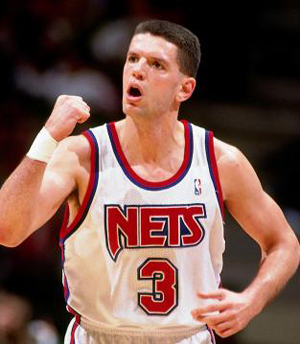
23. Kyrie Irving (Australia) – 21 ppg, 5.7 apg. 3x All-Star (‘13, ‘14, ‘15). All-NBA (‘15).
23 and climbing. In just four seasons “Uncle Drew” has taken the league by storm. Perhaps the only player in the league that can challenge Steph Curry in terms of breaking his man down off the dribble, Irving has quickly become an offensive force at the point-guard position. His ability to hurt defenses without the ball in his hands – in a way that many point guards aren’t comfortable with – makes him the perfect compliment to Lebron, as Irving can hurt teams spotting-up on James’ dribble-drives. Now he just needs to stay on the floor.
22. Zydrunas Ilgauskas (Lithuania) – 13 ppg, 7.3 rpg, 1.6 bpg. Peak- 15.4 ppg, 7.9 rpg, 1.9 bpg
2x All-Star (‘03, ‘05).
“Big Z” was a plodding force with a soft-touch, and though his career was derailed by difficulties with foot injuries, Ilgauskas remained a productive force in the middle for 12 seasons between the Cavs and the Heat, making it to the finals in ‘07 with Cleveland.
21. Arvydas Sabonis (Lithuania) – 12 ppg, 7.3 rpg, 2.1 apg. Peak- 13.7 ppg, 8.6 rpg, 2.2 apg, 1.2 bpg.
The story on Sabonis will always be what-if? What if Sabonis had entered the league at a younger age? But what was, was a very versatile center who still was one of the pioneers of the stretch big-man. What Sabonis had lost in fleet of feet, he compensated for with a guile of play and a complete set of tools. Sabonis was known for his passing, but his numbers even in the twilight of his career were still a fantasy owner’s dream. Will always be remembered for his defensive ability facing Shaq and would be higher if the list wasn’t as NBA focused.
20. Toni Kukoc (Croatia) – 11.6 ppg, 4.2 rpg, 3.7 apg. Peak- 14.5 ppg, 4.9 rpg, 4.3 apg.
NBA Champion (‘96, ‘97, ‘98). 6th Man of the Year (‘96).
Though Kukoc may never have quite reached the expectations that Jerry Krause had for him, the former Croatian swingman played a pivotal role on three Bulls title teams. Kukoc was a deft passer with the ability to stretch defenses, especially when the Bulls went under-sized and played him at the four. In the latter part of his career, Kukoc would later move from Chicago to Milwaukee, showing himself to be a leader on a young Bucks team.
19. Kiki Vandeweghe (Germany) – 19.7 ppg, 52% FG%. Peak- 26.2 ppg, 54% FG%.
2x All-Star (‘83, ‘84)
Vandeweghe was a scorer, in an era of scoring, on a team known for it’s scoring. But what he did, he did as well as almost any player during a five-year stretch; including a season that saw Vandeweghe averaging a career-high 29.4 (‘84). Vandeweghe was in the top five in points 4 out 5 years between ‘83 & ‘87. The foreign-born son of former NBAer Ernie Vandeweghe was known for his scoring acumen for the duration of his career, averaging 16.3 in his last full year as a starter (at age 32) with the Knicks.
18. Rolando Blackman (Panama) – 18 ppg, 3 apg. Peak- 20.7 ppg, 3.8 rpg, 3.5 apg, 51% FG%.
4x All-Star (‘85, ‘86, ‘87, ‘90).
There’s a reason Vandeweghe and Blackman share this proximity on the list. Blackman was another high-level scorer during a time where teams were running and gunning. But Blackman’s doubling-up Vandeweghe in All-Star game appearances earns him the nod. Blackman was a tough scorer who shot a high-percentage for a two-guard, in large-part do to his ability to finish around the rim and to score off of dribble pull-ups.
17. Al Horford (Dominican Republic) – 14.2 ppg, 9.2 rpg, 1.2 bpg 54% FG%. Peak- 16.1 ppg, 8.8 rpg, 1.2 bpg.
3x All-Star (‘10, ‘13, ‘15)
Al Horford epitomizes the terminology "workhorse". Nothing he does is pretty, but it’s damn-sure effective. When healthy, Horford is one of the most complete big-men in the league. Underrated for his lack of flash and undervalued for his wealth of substance, Horford should ascend this list as long as he can stay healthy. Though that’s a big "if", due to Horford’s penchant for accruing nagging issues.
16. Peja Stojakovic (Croatia) – 17 ppg, 4.7 rpg, 40% 3PT%. Peak- 21.1 ppg, 5.5 rpg.
3x All-Star (‘02, ‘03, ‘04). All-NBA (‘03).
Peak-Peja was an absolute offensive force on some very good Kings teams, with an apex season of 24.2 per game in ‘04. And while Peja remained a high-level scorer until ‘08, he made a smooth transition to three-point specialist in the latter part of his career, finally winning a ring in his final season with the Mavericks (‘11).
15. Rik Smits (Netherlands) – 14.8 ppg, 6.1 rpg, 51% FG%. Peak- 17.1, 6.9 rpg. All-Star (‘98).
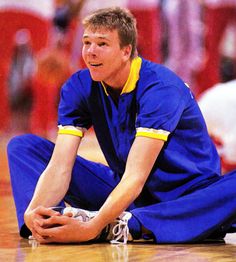
14. Marc Gasol (Spain) – 14.1 ppg, 7.9 rpg, 1.6 bpg, 51% FG%. Peak- 14.5 ppg, 7.7 rpg, 1.6 bpg. Defensive Player of the Year (‘13). 2x NBA All-Star (‘12, ‘15). All-NBA (2x). All-NBA Defense (‘13).
Gasol’s ability to stay healthy, combined with his defensive talents, give him the nod over the more offensively versatile Horford; a very good defensive player in his own right. But Gasol is a defensive game-changer, whose offensive game has continued to evolve into now being a threat both on the low-block and in the pick and pop game. Gasol has now entered the conversation of not only best Gasol in the league (which he is at this point) but the best center.
13. Vlade Divac (Serbia) – 11.8 ppg, 8.2 rpg, 3.1 apg. Peak- 13.7 ppg, 9.5 rpg, 3.6 apg, 1.8 bpg
All-Star (‘01).
Vlade goes down as one the most versatile big-men to play the game. Known equally for his passing, flopping, and smoking, Vlade was a key component of the post-Showtime Lakers team that lost to MJ’s Bulls in ‘90, and later as the pivot-cum-point-center on the same Kings teams that featured Stojakovic and the Turkish born Hedo Turkoglu. Divac’s consistency allowed him to be a prominent producer for the duration of his 15 year career.
12. Detlef Schrempf (Germany) – 13.9 ppg, 6.2 rpg, 3.4 apg. Peak- 17.6 ppg, 7.3 rpg, 4.3 apg.
2x 6th Man of the Year (‘91, ‘92). 3x All-Star (‘93, ‘95, ‘97). All-NBA (‘95).
Schrempf’s peak numbers represent a talented player with a capacity to stuff the stat sheet. Schrempf had the ability to provide scoring punch off the bench, as he showed while winning back-to-back 6th man awards with the Pacers, or as a third-option – as he would do later with the very formidable Supersonics teams of the late 90’s. Schrempf was a consistent producer over his 17-year career, and known as one of the early pioneers for international talents.
11. Dikembe Mutombo (Congo) – 9.8 ppg, 10.3 rpg, 2.8 bpg. Peak- 12.1 ppg, 12.2 rpg, 3.5 bpg.
4x Defensive Player of the Year (‘95, ‘97, ‘98, ‘01). 8x All-Star (‘92, 95-98, ‘00-’02). All-NBA (3x) . All-NBA Defense (6x). 2nd all-time in career blocks.
Mutombo goes down as one of the greatest defensive centers to ever play the game. A four-time Defensive Player of the Year, Mutombo dominated the paint in a way that few players have with such longevity. Even as Mutombo’s already limited offensive game began to wane, the African-born bigman remained a defensive deterrent, and irritant, at the rim until the end of his 18 year career.
10. Yao Ming (China) – 19 ppg, 9.2 rpg, 1.9 bpg. Peak- 21 ppg, 9.6 rpg, 1.9 bpg.
8x All-Star (‘03-’11). All-NBA (5x).
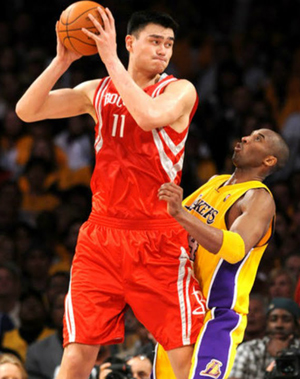
9. Manu Ginobili (Argentina) – 14.3 ppg, 4 apg, 3.8 rpg. Peak- 17.2 ppg, 4.4 apg, 4.2 rpg.
4x NBA Champ (‘03, ‘05, ‘07, ‘14). 2x NBA All-Star (‘05, ‘11). 6th Man of the Year (‘08). All-NBA (2x)
Ginoblli begins the triumvirate of Spurs players that just further prove that San Antonio has the best international presence in the league. His greatest achievement may have been leading a huge underdog Argentina team to Gold medal in Athens. Peak- Ginobili was an All-star or on the fringe for his best stretch, but he was never quite as dominant as the players that rank above him. Yet, his impact on playoff series and his ability to have breakout games at pivotal moments, gets him the top-ten as he is a hall-of-fame player, playing on the dominant machine known as the Spurs.
8. Pau Gasol (Spain) – 18.3 ppg, 9.4 rpg, 51% FG%. Peak- 19.7 ppg, 9.2 rpg.
2x NBA Champion (‘09, ‘10) 5x All-Star (‘06, ‘09-’’11, ‘15).
Since entering the NBA in ‘04, Pau Gasol has been nothing short of a double-double force. The two-time NBA Champion has been both Batman and Robin in his career, and has shown himself to be adaptable in both style of play and offensive approach. Gasol has shown no sign of slowing, having lead the league in double-doubles last season. With two titles, Gasol could arguably be higher on the list.
7. Tony Parker (France) – 16.9 ppg, 5.9 apg. Peak- 18.9 ppg, 6 apg, 51% FG%.
4x NBA Champion (‘03, ‘05, ‘07, ‘14). NBA Finals MVP (‘07). 6x All-Star (‘06, ‘07, ‘09, ‘12-’14) All-NBA (4x).
Born in Belgium, Parker’s personal accolades can’t help but be trumped by the part he’s played in four Spurs championship teams. With that said, Parker has been the best player in a finals’ series, a consistent all-star contender in the perennially point guard heavy Western Conference, and has redefined the way point guards attack the rim off the pick and roll. While Parker may finally be showing the wear and tear that accumulated years of success and deep playoff runs have on the legs, Parker’s career arc has him directed straight to Springfield whenever the time comes. Parker has made a strong case to be in front of Nash due to his titles and better defensive ability, plus he has a chance to add to his legacy.
6. Steve Nash (Canada) – 14.3 ppg, 8.5 apg, 43% 3PT%. Peak- 17.3 ppg, 10.8 apg,
45% 3PT%. 2x NBA MVP (‘05, ‘06). 8x NBA All-Star (‘02, ‘03, ‘05-’08, ‘10, ‘12). All-NBA (7x). 50-40-90 member (4x)
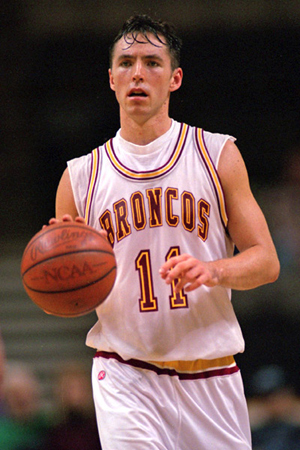
5. Dominique Wilkins (France) – 24.8 ppg, 6.7 rpg. Peak- 28.7 ppg, 6.9 ppg, 12th all-time in career points. 10x All-Star (‘86-’94) All-NBA (7x).
“The Human Highlight Reel” was nothing short of an explosive force and potential creator of poster fodder. Wilkins’ ability to score (28 ppg) over a ten season stretch (‘85-’94) is on par with any of the greats. And while his Hawks teams could never quite distinguish themselves in a monstrous Eastern Conference, ‘Nique was more than ready to answer the bell when it came time to perform. Few players have ever been more athletically or offensively explosive.
4. Patrick Ewing Jr. (Jamaica) – 21 ppg, 9.8 rpg, 2.4 bpg. Peak- 25.6 ppg, 11.3 rpg, 3.0 bpg.
11x All-Star (‘86, ‘88-’97). All-NBA (7x). All-NBA Defense (3x). 7th all-time in blocks. Top-ten in PER (6x).
Patrick Ewing’s dominance in the middle has unfortunately become subjugated through the prism of perceived post-season failures. But Peak-Ewing was one of the most dominant offensive centers the league has witnessed. Ewing’s career numbers remain gaudy, but are pulled-down by a twilight that saw a shell of his former self admirably chasing after that elusive title ring. But, title or not, Ewing dominated the paint in a time where the center position had never been better collectively represented.
3. Dirk Nowitzki (Germany) – 22.2 ppg, 7.9 rpg Peak- 24.7 ppg, 9 rpg. NBA MVP (‘07). NBA Champion (‘11). FInals MVP (‘11). 13x NBA All-Star (‘02-’12, ‘14, ‘15) All-NBA (12x).
Top-ten PER (11x). 7th all-time scoring. 50-40-90 member (‘07).
By any and all measures, Dirk Nowitzki is one of the five best power forwards to ever play in the NBA. A lethal shooter with unlimited range, Nowitzki is undervalued as a rebounder and should be lauded for his ability to lead by both example and motivation. Dirk defies the fallacious belief in the softness of European players, and has helped usher in a shift in the way we perceive perimeter-oriented big-man. Dirk’s Mavericks beating the super-team down in Miami in ‘11 will go down as the crowning achievement of a full and rich NBA career.
2. Tim Duncan (Virgin Islands) – 19.5 ppg, 11 rpg, 2.2 bpg, 3.1 apg. Peak- 23.3 ppg,
12.5 rpg, 2.5 rpg. 2x NBA MVP (‘02,’03). 5x NBA Champion (‘99, ‘03, ‘05, ‘07, ‘14). 15x NBA-Star (‘98, ‘00-’11, ‘13, ‘15). Top-ten PER (13x). All-NBA (15x). All-NBA Defense (14x).
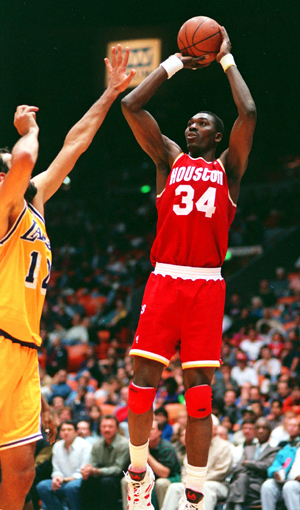
1. Hakeem Olajuwon (Nigeria) – 21.8 ppg, 11.1 rpg, 3.1 bpg, 2.5 apg. 1.7 spg
Peak- 26.2 ppg, 11.2 rpg, 3.3 bpg, 3.5 apg, 1.7 spg. 2x NBA Champion (‘94,‘95). NBA MVP (‘94). 2x NBA Finals MVP (‘94, ‘95). 2x Defensive Player of the Year (‘93, ‘94).
12x NBA-Star (‘85-’90, ‘92-’97). Top-ten PER (13x). (All-NBA (12x). All-NBA Defense (9x).
1st all-time in career blocks, 8th in steals, 10th in points, 13 in rebounds.
Tim Duncan may be inhuman, but Hakeem was sensational. Perhaps the most complete athlete to ever play the center position. His ‘94 season goes down as one of the most completely dominant performances by a single player over the course of a season and playoffs- henceforth ‘94 should just be referred to as the year of “The Dream”. Olajuwon’s offensive creativity was only surpassed by his athleticism and on-court IQ. Olajuwon was able to control any and all facets of the game as evidence by his rank in so many all-time stats. The Nigerian-born former soccer player was the first great international player in the NBA, and showed that even in a sport that requires as much skill as basketball does, athletic virtuosity can still trump all. Olajuwon edges out Duncan barely despite the Big Fundamental being the best player of an era. Unlike Hakeem, Duncan’s era did not include the G.O.A.T.

Nowitzki and Pau
Guys who played for USA national team aren’t Internationals
Nowitzki and Pau Gasol are two best International players all time
This.
"Guys who played for USA national team aren’t Internationals"
This.
Playing with Team USA does
Also, playing with Team USA does nothing to change if a player is international. This is not a xenophobia forum.
That’s not at all what he was
That’s not at all what he was saying. He’s saying that being born in abroad but spending the entirity of your life in the US makes you as American as uncle sam. The player doesn’t speak the native language, knows no one from that country, and would be shocked by the culture if he ever visited. It has nothing to do with xenophobia.
Hakeem
"Guys who played for USA national team aren’t Internationals"
So, then you have to look at Hakeem prior to 1996, because until he played for the Dream Team in 1996, he was clearly an "international." When you do that, he’s even more clearly the #1 choice, since he was not as good after 1996.
Nowitzki and Pau
Guys who played for USA national team aren’t Internationals
Nowitzki and Pau Gasol are two best International players all time
This.
"Guys who played for USA national team aren’t Internationals"
This.
Playing with Team USA does
Also, playing with Team USA does nothing to change if a player is international. This is not a xenophobia forum.
That’s not at all what he was
That’s not at all what he was saying. He’s saying that being born in abroad but spending the entirity of your life in the US makes you as American as uncle sam. The player doesn’t speak the native language, knows no one from that country, and would be shocked by the culture if he ever visited. It has nothing to do with xenophobia.
Hakeem
"Guys who played for USA national team aren’t Internationals"
So, then you have to look at Hakeem prior to 1996, because until he played for the Dream Team in 1996, he was clearly an "international." When you do that, he’s even more clearly the #1 choice, since he was not as good after 1996.
Dominique over Nash is
Dominique over Nash is laughable.
Dominique over Nash is
Dominique over Nash is laughable.
have to agree nique over nash
have to agree nique over nash very questionable. and i agree with zola on duncan but you cant hold being a naturalized player against anyone he put the time in, and nigeria wasnt making any runs to the olympics it is a dream of some people to play in those events
Not just that he played for
Not just that he played for USA national team, he went to american college and played whole career in USA. He is american product
have to agree nique over nash
have to agree nique over nash very questionable. and i agree with zola on duncan but you cant hold being a naturalized player against anyone he put the time in, and nigeria wasnt making any runs to the olympics it is a dream of some people to play in those events
Not just that he played for
Not just that he played for USA national team, he went to american college and played whole career in USA. He is american product
i enjoyed reading this
i enjoyed reading this article…
but no way should divac be rated ahead of marc gasol..
i think rik smits is rated a little too high..
Divac vs. Marc Gasol
"but no way should divac be rated ahead of marc gasol"
That’s bonkers. Divac did for 15 years what Gasol has done for 7, plus Divac is one of the best passers in NBA history.
i enjoyed reading this
i enjoyed reading this article…
but no way should divac be rated ahead of marc gasol..
i think rik smits is rated a little too high..
Divac vs. Marc Gasol
"but no way should divac be rated ahead of marc gasol"
That’s bonkers. Divac did for 15 years what Gasol has done for 7, plus Divac is one of the best passers in NBA history.
I don’t bout dirk rated ahead
I don’t bout dirk rated ahead of Ewing!! And nique was a better scorer and dominant than Nash!!!
I don’t bout dirk rated ahead
I don’t bout dirk rated ahead of Ewing!! And nique was a better scorer and dominant than Nash!!!
Kyrie being born in Australia
Kyrie being born in Australia doesn’t make him Australian. His parents are both American. He spent a handful of months here before moving to New Jersey. He is American through and through
Kyrie being born in Australia
Kyrie being born in Australia doesn’t make him Australian. His parents are both American. He spent a handful of months here before moving to New Jersey. He is American through and through
Drazen Petrovic at 24 is
Drazen Petrovic at 24 is laughable… even with his shortened NBA career. He’s the best international player of all-time bar none and shot at such an efficient rate that his shooting slash line wasn’t duplicated by a guard since Dragic two years ago (over 20 years). Additionally, Peja did not represent Croatia, he identified as Serbian. Lastly, Arvydas Sabonis deserves to be on the list because he is the 2nd or 3rd best international player of all time.
Peja was born in Croatia, he
TenSecondTom, Peja was born in Croatia, he is Serbian descent, and he idenitifies as a Greek, which is his chosen nationality, and also the national team he wanted to play for, but was not able to because of the political situation at the time. So you are not correct.
Peja
Peja was born in Croatia because many Serbians lived there in the past (like Nikola Tesla), but he never wanted to play for Greece. He took greek citizenship and passport so he could travel easier and to free space for another foreign player in PAOK. Greece tried to take adventage of hard situation in which Serbia was in 90-ies because of political, economical and sporting sanctions and to steal Stojakovic, Jaric, Gurovic, Tarlac… but all of them choose to play for their country
Drazen Petrovic at 24 is
Drazen Petrovic at 24 is laughable… even with his shortened NBA career. He’s the best international player of all-time bar none and shot at such an efficient rate that his shooting slash line wasn’t duplicated by a guard since Dragic two years ago (over 20 years). Additionally, Peja did not represent Croatia, he identified as Serbian. Lastly, Arvydas Sabonis deserves to be on the list because he is the 2nd or 3rd best international player of all time.
Peja was born in Croatia, he
TenSecondTom, Peja was born in Croatia, he is Serbian descent, and he idenitifies as a Greek, which is his chosen nationality, and also the national team he wanted to play for, but was not able to because of the political situation at the time. So you are not correct.
Peja
Peja was born in Croatia because many Serbians lived there in the past (like Nikola Tesla), but he never wanted to play for Greece. He took greek citizenship and passport so he could travel easier and to free space for another foreign player in PAOK. Greece tried to take adventage of hard situation in which Serbia was in 90-ies because of political, economical and sporting sanctions and to steal Stojakovic, Jaric, Gurovic, Tarlac… but all of them choose to play for their country
Sooooo American players who
Sooooo American players who happened to be born overseas are no longer considered to be American then???? (Sarcasm)
Sooooo American players who
Sooooo American players who happened to be born overseas are no longer considered to be American then???? (Sarcasm)
how about this?
AK47 ???
Okur???
I think they have in this list
how about this?
AK47 ???
Okur???
I think they have in this list
Kobe
Where’s Kobe he was born in Italy.
Naw he was born in Philly, he
Naw Kobe was born in Philly, he moved to Italy when he was a kid
Kobe
No, he was born in Pennsylvania.
Kobe
Where’s Kobe he was born in Italy.
Naw he was born in Philly, he
Naw Kobe was born in Philly, he moved to Italy when he was a kid
Kobe
No, he was born in Pennsylvania.
Boozer, Irving, Vandeweghe,
Boozer, Irving, Vandeweghe, and Nique do not meet any reasonable definition of “international.” Rolando Blackman may not either. He grew up here and is a citizen, but if he was born a Panamanian (his birth citizenship has never been clear to me), at least there’s some justification to including him on this list. I’d also quibble with the guys who played HS ball in the US (such as Horford, Ewing and Marc Gasol), but it’s reasonably justified to include them on this list.
That said, the most ridiculous name on this list is obviously Duncan who was both (1) born a U.S. citizen; and (2) not born in a foreign country, since the US Virgin Islands are, shock!, part of the U.S.
Also, that’s Patrick Ewing, Sr., not Jr., on this list.
Boozer, Irving, Vandeweghe,
Boozer, Irving, Vandeweghe, and Nique do not meet any reasonable definition of “international.” Rolando Blackman may not either. He grew up here and is a citizen, but if he was born a Panamanian (his birth citizenship has never been clear to me), at least there’s some justification to including him on this list. I’d also quibble with the guys who played HS ball in the US (such as Horford, Ewing and Marc Gasol), but it’s reasonably justified to include them on this list.
That said, the most ridiculous name on this list is obviously Duncan who was both (1) born a U.S. citizen; and (2) not born in a foreign country, since the US Virgin Islands are, shock!, part of the U.S.
Also, that’s Patrick Ewing, Sr., not Jr., on this list.
Thanks for informative Post,
Thanks for informative Post, i Really Enjoyed reading this article.
IBPS PO Result 2016
Thanks for informative Post,
Thanks for informative Post, i Really Enjoyed reading this article.
IBPS PO Result 2016